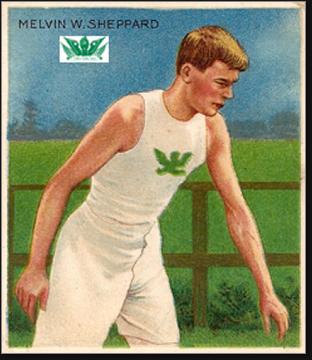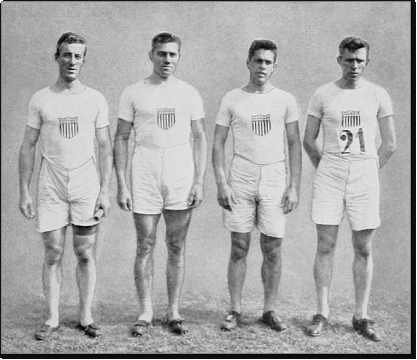
Mel Sheppard
Sport: Track & Field
Born: September 5, 1883
Died: January 4, 1942
Town: Deptford
Melvin Winfield Sheppard was born September 5, 1883 in Deptford Township. Mel worked in a glass factory as a boy for 50 cents a day, until his family resettled in Philadelphia near the end of the 1890s. As a teenager, Mel was a brawling street thug, a member of the Gray’s Ferry Roaders.
Mel was strong and fast, with excellent endurance. He grew to 5–9 and competed at a wiry 145 pounds. Up until age 17, he employed this talent as a messenger (and occasionally running from the cops). But after his family moved to West Philly, he joined the Preston Athletic Club.
In his late teens he enrolled at Brown College Preparatory School in downtown Philadelphia. An African American classmate, John Taylor, would be both a teammate and rival for more than a decade. While at Brown Prep, Mel broke the world interscholastic record for the mile, shaving a jaw-dropping 11 seconds off the previous record.
Unlike most of the boys at Brown, Mel had little intention of actually attending college. One year earlier, he had been accused of competing in a race in Queens under the name of Alvin Smith, putting his amateur standing in jeopardy. The AAU eventually exonerated him for lack of evidence. Mel actually set his sights on a career in law enforcement, but was rejected by the New York Police Department when doctors detected a slightly enlarged heart.
Mel became a prominent member of local running clubs in his early 20s, including the Irish American Athletic Club. He excelled at the middle distances, from 400 meters to 1500 meters. He competed in AAU events beginning around age 20 and at age 22 was crowned national champion at 880 yards. Mel defended his 880 crown in 1907 and again in 1908. In 1907. Mel set world indoor records at four distances: 600, 880 and 1,000 yards, as well as the mile.
Mel’s strategy in most races was to set a blistering pace and then hold off his pursuers. When sheer speed was not enough to accomplish this, he was not above physically intimidating or blocking other runners. On the rare occasions when he was passed, Mel sometimes chose to walk off the track rather than finish off the pace.
Mel’s nemesis during this time was Guy Haskins, a New Zealander studying dentistry at the University of Pennsylvania. As the 1908 Olympics approached, it seemed the two would continue their rivalry in London, but Haskins was not chosen (presumably because of his birthplace), nor was he selected to compete for Australaisa.
In London, Mel won his preliminary 1500 meters heat in world record time. That record didn’t last long, as Englishman Norman Hallows shaved more than a second off in his qualifying race. Mel matched the 4:03.6 record when they ran head-to-head, which was good enough to take the gold medal. In the 800 meters, Mel won another gold medal, improving on the previous Olympic record by 3.2 seconds. The remarkable thing about this record was that Mel rarely ran the 1,500—and hadn’t even run the event in the Olympic trials.
Mel’s third gold medal in the 1908 Olympics came on the anchor leg of the 1600 meter relay. The race was broken into uneven segments of 200, 200, 400 and 800 meters. Red Hamilton started the race for the U.S. team, handing off to Nate Cartmell, who delivered the baton to John Taylor. Taylor, who moments later would become the first African American to win a gold medal, built a 15-yard lead before handing off to Mel, who ran a lightning-fast 800 meters and broke the tape three seconds ahead of the Germans and Hungarians.
Back in America, Mel found he had a highly placed admirer. President Theodore Roosevelt, a former athlete in college, was obsessed with Mel’s 1500 record. In a private meeting, TR asked him to recount every detail of the race. Afterwards, Mel offered the president his 1500 gold medal, saying he had three so he could spare one. Roosevelt counted it among his most treasured possessions.
Mel continued to dominate the middle distances, while his Irish American club was tough to beat in relays. In 1909, Mel broke the mile relay record along with teammates William Robbins, CS Cassara and James Rosenberger, the IAAC’s best sprinter. In 1911 and 1912, Mel was the AAU champion at 880 yards. In 1911, he was part of the club’s 4 x 400 team that set a world record.
 Mel supported himself as a port inspector—first in Philadelphia and later in New York. Rumor had it that President Roosevelt had helped him secure this job. He was on duty the April night when the Carpathia arrived with the survivors of the Titanic sinking. Mel supported himself as a port inspector—first in Philadelphia and later in New York. Rumor had it that President Roosevelt had helped him secure this job. He was on duty the April night when the Carpathia arrived with the survivors of the Titanic sinking.
Mel traveled to Stockholm in 1912 to defend his Olympic 800 meters title. In the final, he was passed by Ted Meredith, who went on to set a world record. Mel took the silver medal, with a third American, Ira Davenport, winning the bronze. Mel competed in the 400, but did not win his qualifying heat. Mel won his 1500 meter qualifier with a time of 4:27, but could not crack the Top 3 in the final. He did leave Stockholm with a 4th gold medal, as the lead runner on the 4 x 400 relay squad (left), which broke his running club’s previous record.
After the Olympics, Mel was hired by Philadelphia millionaire John Wanamker to become the recreational director for the employees of his department store. He also helped organize the Millrose Games in New York—a track meet that he had previously headlined as a competitor. Mel served in World War I as athletic director at a number of military bases, getting new recruits in fighting shape.
During the 1920s and 1930s, while continuing to work for Wanamaker’s, Mel also coached running clubs and traveled the country for the U.S. government to help set up urban playgrounds. In 1928, he coached the U.S. women’s Olympic track team in Amsterdam. Everyone who was anyone in the running world knew Mel. passed away at age 59 in Queens, possibly from an untreated ulcer or a burst appendix.
|